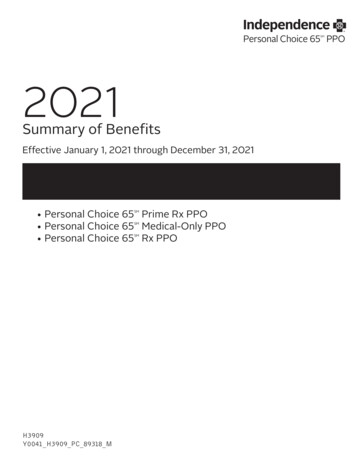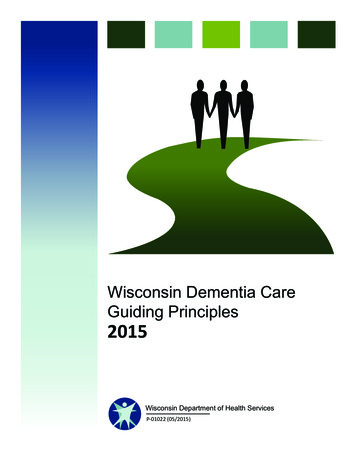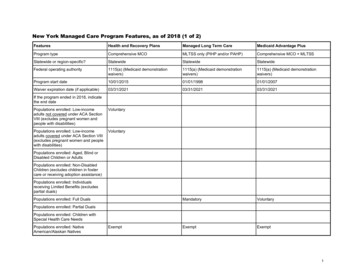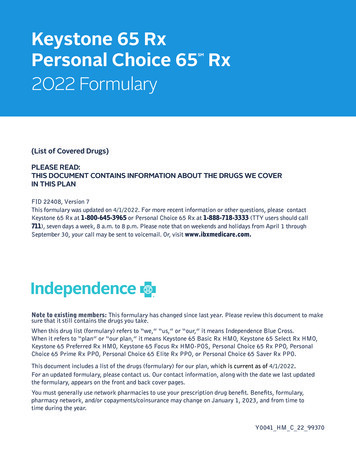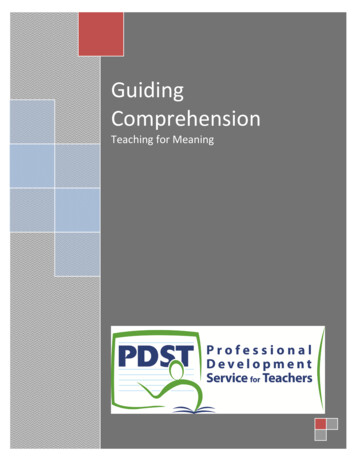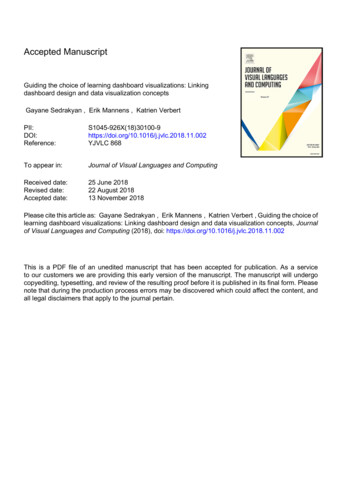
Transcription
Accepted ManuscriptGuiding the choice of learning dashboard visualizations: Linkingdashboard design and data visualization conceptsGayane Sedrakyan , Erik Mannens , Katrien s://doi.org/10.1016/j.jvlc.2018.11.002YJVLC 868To appear in:Journal of Visual Languages and ComputingReceived date:Revised date:Accepted date:25 June 201822 August 201813 November 2018Please cite this article as: Gayane Sedrakyan , Erik Mannens , Katrien Verbert , Guiding the choice oflearning dashboard visualizations: Linking dashboard design and data visualization concepts, Journalof Visual Languages and Computing (2018), doi: https://doi.org/10.1016/j.jvlc.2018.11.002This is a PDF file of an unedited manuscript that has been accepted for publication. As a serviceto our customers we are providing this early version of the manuscript. The manuscript will undergocopyediting, typesetting, and review of the resulting proof before it is published in its final form. Pleasenote that during the production process errors may be discovered which could affect the content, andall legal disclaimers that apply to the journal pertain.
ACCEPTED MANUSCRIPTHighlightslittle is known theoretically on the dashboard design principles earlier research links design and educational science concepts to design feedback we extend earlier research by linking dashboard design and visualization concepts general recommendations are derived to guide the choice of visual representations a case example is given showing visualizations per intended feedback / goalACCEPTEDMANUSCRIPT
ACCEPTED MANUSCRIPTWe confirm that this manuscript has not been published elsewhere and is not under considerationby another journal. All authors have approved the manuscript and agree with its submission toJournal of Visual Languages and Computing.This work was supported by Internal Funds of KU Leuven - PROFEELEARN PDM/16/044Please consider the following order of authors and corresponding affiliations.CRIPTGuiding the choice of learning dashboard visualizations: Linking dashboard design and datavisualization conceptsGayane Sedrakyan (author 1)Affiliation 1:Department of Computer ScienceANUSKU LeuvenResearch Center for Human Computer InteractionCelestijnenlaan 200a, 3001 Leuven, BelgiumOffice number: 04.167MTel: 32 (0) 16 32 86 43EDE-mail: gayane.sedrakyan@kuleuven.beAffiliation 2:PTIMEC / IDLab – Ghent UniversityFaculty of Engineering and ArchitectureCEAA Tower, Technologiepark 19, 9052 Zwijnaarde, BelgiumACE-mail: gayane.sedrakyan@ugent.beErik Mannens (author 2)IMEC / IDLab – Ghent UniversityFaculty of Engineering and ArchitectureAA Tower, Technologiepark 19, 9052 Zwijnaarde, BelgiumE-mail: Erik.Mannens@ugent.be
ACCEPTED MANUSCRIPTKatrien Verbert (author 3)KU LeuvenDepartment of Computer ScienceResearch Center for Human Computer InteractionCelestijnenlaan 200a, 3001 Leuven, BelgiumOffice number: 04.49CRIPTTel: 32 (0) 16 32 82 86E-mail: ence concerning this article should be addressed to Gayane Sedrakyan(gsedrakyan@gmail.com; Gayane.sedrakyan@kuleuven.be; gayane.sedrakyan@ugent.be).
ACCEPTED MANUSCRIPTGuiding the choice of learning dashboardvisualizations: Linking dashboard design anddata visualization conceptsAbstractANUSCRIPTLearning dashboards are known to improve decision-making by visualizing learning processesand helping to track where learning processes evolve as expected and where potential issues (may)occur. Despite the popularity of such dashboards, little is known theoretically on the designprinciples. Our earlier research reports on the gap between dashboards’ design and learning scienceconcepts, subsequently proposing a conceptual model that links dashboard design principles withlearning process and feedback concepts. This paper extends our previous work by mapping thedashboard design and data/information visualization concepts. Based on a conceptual analysis andempirical evidence from earlier research, recommendations are proposed to guide the choice ofvisual representations of data in learning dashboards corresponding to the intended feedbacktypology.1. IntroductionCEPTEDMAdvances in educational technologies have generated increased interest in previously nonfeasible approaches to provide process-oriented feedback (Sedrakyan, 2016) in the form of learningdashboards. Examining how learners interact within virtual learning environments (i.e., with eachother, instructors, the environment) provides opportunities to reveal where things are progressingwell and where problems may possibly occur (Sedrakyan, Malmberg, Verbert, Järvelä & Kirschner,2018). Using this information, feedback can be provided that can help teachers and learners enhanceengagement and achievement (Gaševid, Dawson, Rogers, & Gasevic, 2016). Such feedback ispresented in the form of visualizations in teacher- and learner-oriented dashboards (Bodily &Verbert, 2017; Dyckhoff, Zielke, Bültmann, Chatti, & Schroeder, 2012; Hu, Lo, & Shih, 2014; Mottus,Graf, & Chen, 2015). Furthermore, visualizations are often the only reasonable approach to analyzedata to gain knowledge about the underlying processes and relations (Lange, Schumann, Müller, &Krömker, 1995).ACDespite the popularity and the proliferation of dashboard solution providers, little is knownabout their design aspects to support the choice of visualizations when developing such dashboards.As stated by Lange et al. (1995), deciding on the right visualization methods is not easy at all: the usermust be an expert to generate an effective visualization which considers the goal in mind andrenders the characteristics of the given data set. Otherwise, the produced visualizations can bemisguiding and, as a consequence, may lead to wrong conclusions. Furthermore, while the topic ofvisualizations is very popular in data science education, teaching visualizations rather targets how tomake a chart before even thinking about whether it is appropriate (Stoltzman, 2017).Our previous work reports on the gap between Learning Analytics Dashboard (LAD) designand learning science concepts (Sedrakyan, Järvelä & Kirschner, 2016), exploring the links between thetypology of feedback relevant for different learning goals and dashboard design concepts. Inaddition, we have proposed a conceptual model that links dashboard design with learning processand feedback concepts (Sedrakyan, Malmberg, Verbert, Järvelä & Kirschner, 2018). This paperextends our previous work by further linking the dashboard design and visualization concepts. Based
ACCEPTED MANUSCRIPTon a conceptual analysis and empirical evidence, recommendations are proposed for the choice ofvisual representations of data for different learning goals and feedback.CRIPTMethodology-wise, the work builds on earlier work on data visualization paradigms. Inparticular, literature on scientific data visualization methodologies was considered as a starting point.In addition, the goal orientation approach has been considered, which assumes mapping the types ofinformation that the visual representations convey with the intrinsic characteristics of data and aimsfor interpretation. Our work extends these studies with the specific scope of learning relatedinformation visualization in the context of LADs. In particular, the contribution of the work includesthe mapping of visual representation properties with the general aims of dashboards derived fromearlier literature as well as meta-level aims such as feedback typology, learning goals, learningprocess regulation, learning effectiveness, etc.2. MethodologyPTEDMANUSAs Kerlinger (1979) noted in the seventies of the previous century, theories present asystematic view of phenomena by specifying relations among variables using a set of interrelatedconstructs/variables, definitions, and propositions. A conceptual framework can guide research byproviding a visual representation of theoretical constructs (and variables) of interest (Creswell, 1994).In this paper, we aim to derive a conceptual framework to guide the design and development ofeducational dashboard visualizations. We then visualize the derived concepts and their relationshipthrough a conceptual map. We further illustrate the conceptual framework using a case example thatincludes several visualization examples per intended goals and data characteristics. Not manypublications can be found in the context of visualization paradigms/frameworks. Towards developinga stronger theoretical basis for visualization in scientific computation, Robertson (1990) bases themethodology for scientific data visualizations on objectively distinguishing the types of informationconveyed by various visual representations and matching these to the intrinsic characteristics of dataand to aims for its interpretation. Our work follows this approach by presenting recommendationsbased on the mappings between learning process variables and visualizations as well as the aims forinterpretation, i.e., intended goals (e.g., feedback typology) and data properties in the context ofLADs. The mappings are presented in a tabular format that explicitly link the relationships betweeneducational concepts, LADs designs, visual paradigms concepts, and possible visualizations based onthe tasks/aims for visualizations.CE3. Classification of LADs based on earlier studiesACIn this section, we provide a brief overview of learning dashboards based on earlier studies interms of the objectives, stakeholders, as well as general trends and expectations for future LADinstruments.There are numerous studies discussing the benefits of using dashboards in education fornovel feedback opportunities that may enhance learning (e.g. Duval et al., 2012; Dyckhoff et al.,2012; Hu et al., 2014; Mottus et al., 2015; Verbert et al. 2013; Verbert et al. 2014; Bodily & Verbert,2017). These studies can be further classified based on the intended goals, stakeholders, feedbacktypology, data, and analytics approaches. Among others, LADs aim to support improved retention orengagement, increased social behavior or recommendations of courses and resources (Bodily &Verbert, 2017), both for individual and group learning purposes (Upton & Kay, 2009).
ACCEPTED MANUSCRIPT3.1. Stakeholders, intended goals/interventions, data sources and analytics approachesFrom the perspective of the potential users, Klerkx et al. (2017) distinguish the followingstakeholders: learner, teacher, administrator, and researcher. Ifenthaler & Widanapathirana (2014)generalize the users into the following stakeholders: mega-level (governance), macro-level(institution), meso-level (curriculum, teacher/tutor), and micro-level (learner).ANUSCRIPTIn terms of the intended goals of dashboards, most studies limit themselves to studentperformance outcomes through self-reflection, awareness, and self-assessment (Bodily & Verbert,2017) positioning learners in comparison with teacher specified and/or peer performance. SeveralLADs deliver cognitive feedback in a limited context, such as mathematical problems or formalassessment of writing drafts (Ferguson et al., 2016). Based on earlier studies on LADs and toolsintroduced, Park & Jo (2015) provide an overview of existing LAD instruments for different usergroups as follows: The intended goals of LADs for teachers include 1. to provide feedbacks onstudents’ learning activities and performance; 2. to identify and treat students at-risk; and 3. tovisualize the evolution of participant relationships within discussion forums. The intended goals ofLADs for students include: 1. to improve retention and performance outcomes; and 2. to helpstudents see how well they are contributing to the group to improve group-work. The intended goalsof LADs that target both teachers/students include: 1. to keep track of learners’ interaction in elearning systems; 2. to provide a visualization of learning performance with a comparison of wholeclass/group; 3. to enable students’ self-reflection and awareness of what and how they are doing;and 4. to promote reflection and awareness of their activity.MRelatively recent research also introduces the needs for considering learning goals andorientations, effectiveness, and efficiency of learning processes, and subsequently dashboardfeedback design (Sedrakyan et al. 2018) that provides feedback mechanisms based on the linksbetween learning analytics and learning science concepts. Such a LAD targets learners both atindividual and group level to improve learning processes and outcomes, as well as teachers to alsohelp adapting an instructional design (Sedrakyan et al., 2018).CEPTEDFrom the perspective of the intended interventions based on learning analytics, Schumacher,& Ifenthaler (2018) classify the following types of feedback: summative feedback (understandlearning habits, compare learning paths, analyze learning outcomes, and track progress towardsgoals); real-time feedback (receive automated interventions and scaffolds and take assessmentsincluding just-in-time feedback) and predictive feedback (optimize learning paths, adapt torecommendations, increase engagement, and increase success rates). Sedrakyan (2016) uses aconcept of process-oriented feedback distinguished by two general types of feedback: cognitivefeedback (e.g., targeting at understanding related issues) and behavioral feedback (e.g., targeting atprocedural types of issues). The latter type of feedback is further exploited in the context ofregulated learning (Sedrakyan, 2016; Sedrakyan et al., 2016; 2018).ACWith regard to data sources, learning analytics use static (e.g., stored in spreadsheets, textfiles, databases, etc.) and dynamic (i.e., moving data such as stream of data from sensors, socialmedia, and a log file during a learning process that allows to observe patterns and changes over timeto possibly adapt real-time) information about learners and learning environments allowingassessing, eliciting, and analyzing them for real-time modeling, prediction, and optimization oflearning processes, learning environments, and educational decision-making (Ifenthaler, 2015). Fromthe data analytics perspective, in addition to statistical and data mining approaches targetingsummative and outcome-oriented data visualizations, Sedrakyan (2016) highlights the need forprocess/sequence analytics to consider the procedural aspects in learning processes.In terms of data collection, most studies are limited to logs that address university settings(Schwendimann et al., 2016). In terms of analysis approach in the context of LADs feedback, datamining approaches prevail targeting performance visualization and outcome feedback (“How do I
ACCEPTED MANUSCRIPTperform?”). Such dashboards are in addition limited to summative representations without focusingon support mechanisms to facilitate their interpretation (Bodily & Verbert, 2017; Park & Jo, 2015).Recent research also introduces the concept of process-oriented feedback for a broader learningprocess context outside university settings (“How can I do better?”, e.g., by looking for inefficientprocedural and sequential aspects of learning processes) based on process analytics approaches(Sedrakyan, 2016; Sedrakyan, Snoeck, & De Weerdt, 2014; Sedrakyan, De Weerdt, & Snoeck, 2016).ANUSCRIPTWhile most of learning analytics tools are making use of learner activities for differentlearning tasks or administrative data, recent research shows increased interest in observing learneractivities outside the learning environments as learning processes are not limited to learningactivities within a learning environment. For instance, Di Mitri et al. (2016) observe the levels ofproductivity, stress, challenge and the potential impact on learning. This is an emergent researcharea for LADs that also focuses on biofeedback perspectives that can be achieved based onphysiological data analytics collected from wearable sensors1 as well as dashboard feedback onemotions (Leony et al., 2017; Sedrakyan, Leony, Muñoz-Merino, Kloos, & Verbert, 2017). Otherexamples may include network analytics (e.g., understanding the influence of social networks,behavior of using devices/software, etc.), eye tracking analytics (e.g., observing the use of resourcesoutside a learning environment and analyzing how those were integrated by a learner during alearning task completion), etc.3.2. Other expectationsEDMBesides the overall goals and expectations from LAD instruments discussed above, Schumacher &Ifenthaler (2018) also highlight the relevance of system expectations such as the capability to allow ahigh degree of customization. With the introduction of MOOCs, big data (analytics) relateddimensions became relevant in the literature on learning dashboards. In addition, recent researchshows increased interest in exploring biofeedback opportunities based on multi-modal data collectedfrom various wearable sensors and audio/video streams. Thus, scalability is yet another requirementfor learning analytics dashboards that use large volumes of (live) learner data (such as data fromwearable sensors) collected from various sources in a variety of data formats.PT3.3. Summary of LAD conceptsTable 1 shows an overview of LADs classification based on earlier studies discussed in thissection.ACCETable 1 Overview of LADs classifications based on intended goals, stakeholders, data sources, and analytics approachesFeedback *awareness of learning process and progresssupport cognitive processesaffect behavioroutcome-oriented (e.g., achievement level)process-oriented (e.g., procedural information)summative (e.g., results, resource/time usage, etc.)real-time (immediate feedback during a learning process)predictive (e.g., identify failure risks)Mega-level (governance)1support decision making in educational domain foroptimization of the field, KPI visualization, benchmarkingStrategic regulation of learning through Learning Analytics and Mobile clouds for individual andcollaborative learning success (SLAM) project, funded by the Academy of Finland.
ACCEPTED MANUSCRIPTStakeholdersidentify issues and support decision making, optimizationof learning processes, learning environments, andeducational decision-making, analytics, feedbackautomationprovide feedback on students’ learning activities andperformancehelp to identify (predict) and treat students at-riskMeso-level (curriculum, teacher/tutor) visualize the evolution of participant relationships withindiscussion forums; group interactionsimprove retention and performance outcomesto help see how well they are contributing to the groupMicro-level (learner)to improve group-workto help adapting instructional designkeep track of learners’ interaction in e-learning systemsprovide a visualization of learning performance with acomparison of whole class/groupCombined (teacher & learners)to enable students’ self-reflection and awareness of whatand how they are doingpromote reflection and awareness of their activity andfeelingsSummative representations based on statisticsSequential representations based on process analyticsPredictive analytics based on machine learning or predictive models (feature engineering)Static (e.g., stored in spreadsheets, text files, databases, etc.)Dynamic (e.g., moving data such as stream of data from sensors, social media, a log file during alearning observe changes in behavior over time to possibly adapt real-time feedback/predictionmodels, etc.)Online (obtained from digital sources)Within learning environmentsOutside learning environmentsOffline (obtained through non-digital sources, e.g., offline learning tasks, etc.)Multi-modal (video/audio/sensor streams, hybrid – combinations of multiple datasets that can be aswell of heterogeneous origins)Scalability (e.g., relevant to MOOCs, big data obtained from sensors)High degree of customization (interactivity and adaptability to end-user preferences, searchability,zoom into different abstraction/granularity levels, etc.)OtherexpectationsANUSMData sourcesEDData/analyticsapproachesCRIPTMacro-level (institution,e.g., administrator, researcher)PT* the types of feedback are not mutually exclusive, e.g., awareness can be supported by summative, cognitive, processoriented, real-time feedback, etc., while process-oriented feedback can use a combination of cognitive and behavioralfeedback that may also be outcome-oriented for intermediate learning achievements to improve a final outcomeACCEIn summary, LADs in earlier studies can be classified based on the intended goal (e.g.,summative outcomes, real-time process-oriented feedback, and predictive), stakeholders (e.g.,learners, teachers, administrators, researchers, etc.) classified into mega-, macro-, meso- and microlevel users, type of learning tasks (e.g., problem solving, solo, group learning, ), feedback typology(cognitive and behavioral), data analytics characteristics (e.g., static/dynamic data with different levelof dimensionality and aggregations analyzed by statistical, data mining, and process/sequenceoriented techniques). As already mentioned, visualizations are often the only reasonable approachused to analyze and gain knowledge from various learning datasets about the underlying learningprocesses and relations. However, while recent research discusses the needs and ways of linkingdashboard and learning science concepts to improve the accuracy and effectiveness of LAD solutions,to the best of our knowledge, there is no publication that provides theoretical support for the choiceof visualization representations to guide their design and development process. Our work targets thisspecific gap by highlighting the meta-level links between dashboard design aspects (intended goal,stakeholders, type of learning tasks, feedback typology, data and analytics characteristics) andvisualization concepts in the context of learning dashboards.In this work, we will focus on the following subset of LAD properties:
ACCEPTED MANUSCRIPT-Learners (individual and group) and teachers as stakeholders;Feedback or needs for instructional design adaptation in the form of both outcome andprocess visualizations targeted to affect awareness, cognition, behavior;Learner data both inside/outside learning environments.4. Educational science concepts relevant for dashboard feedback designACCEPTEDMANUSCRIPTRecent research on dashboards also highlights several issues and trends for future solutions.For instance, research shows that while most dashboards and the feedback that they give are basedonly on learner performance indicators, effective feedback needs also to be grounded in theregulatory mechanisms underlying learning processes and awareness of the learner’s learning goals(Sedrakyan, et al., 2018). Furthermore, recent research on the effectiveness of learning analyticstools reveals that when using performance-oriented dashboards, learner mastery orientationdecreases (Lonn, Aguilar, & Teasley, 2015). This suggests that such goal orientations need to becarefully considered in the design of any intervention, as the resulting approaches and tools canaffect students’ interpretations of their data and subsequent academic success (Lonn et al., 2015).Earlier studies on learning dashboards highlight a number of dimensions that need to be consideredwhen designing feedback dashboards. Sedrakyan et al. (2018) provide an overview of the conceptsthat need to be considered to support the links between dashboard design and educational sciencesand allow effective observing of learning processes with respect to potential feedback needs ofdifferent learners for different learning goals, as well as for teachers to assess the needs forinterventions or adaptations in instructional design. Different theories have attempted to explain theprocess of how people learn. While there is no complete agreement between these theories, mostagree that learning may be explained by two basic approaches and their combinations: cognitivetheories (i.e., cognitivism, which views the learning process as a step-by-step knowledge constructionprocess) and behavioral theories (i.e., behaviorism, in which learning is defined as a change of thebehavior of a learner by reinforcing some aspect of her behavior; Tomic, 1993). As learning ismultifaceted, these approaches are often intertwined. For instance, in sociocognitive learning theory(Bransford, Brown, & Cocking, 2000), learners are acting as constructors of their knowledge byreinforcing themselves with goal-directed behavior, which can be referred to as a sequencing ofcognitive and behavioral activities (regulated learning). In the context of feedback research, theseapproaches translate into two major forms that can also be combined: 1) explanations that targetimproving the cognitive dimensions of knowledge acquisition (e.g., understanding) and 2) guidanceintended to influence a learner’s behavior (e.g., engaging in a specific type of activity believed to berelated to a successful learning path; Sedrakyan, 2016). Cognitive feedback gives information tolearners about success or failure concerning the task at hand through prompts, cues, questions, etc.,that help learners to reflect on the quality of the problem-solving process (e.g., reasoning, thinking,and understanding). This type of feedback aims to improve learners’ understanding of intermediatesolutions allowing them to engage in self-regulatory learning mechanisms (van Merriënboer &Kirschner, 2012).4.1. Feedback and regulation of learningPrevious studies (Alvarez, Espasa, & Guasch, 2012; Guasch, Espasa, Alvarez, & Kirschner,2011, 2013) identify different types of cognitive feedback, such as corrective, epistemic or suggestivefeedback, and their combination. Corrective feedback provides comments to the learner about theadequacy of learners’ work (e.g., “This is not correct. The correct answer is ”). Epistemic feedbackrequests and/or stimulates explanations and/or clarifications in a critical way (e.g., “Do you thinkwhat you have written reflects what the author means in her study? Why do you think that X is anexample of what the author is saying?”). Suggestive feedback (sometimes referred to as directivefeedback) includes advice or directions to the learner on how to proceed and/or continue and invites
ACCEPTED MANUSCRIPThim or her to explore, expand, or improve what he or she has done (e.g., “Giving an instance or anexample of your position at the end of your argument would make your point both clearer andstronger”). Of course, it is sometimes possible to combine them (e.g., epistemic and suggestive).ANUSCRIPTIn contrast to cognitive feedback that is given in the context of learning tasks such asproblem-solving, behavioral feedback targets a change in behavior. This type of feedback relates tolearner goals and targets improved awareness of the learning progress and potential regulationneeds during the learning process. In the context of dashboards, the role of this type of feedback isto inform a learner whether he or she is “on track on his or her road map.” This theory can beexploited in the context of self-regulated learning (Butler & Winne, 1995). The regulation of learningis a central topic in research on feedback, which is defined as a learner’s ability to monitor andevaluate his or her progress with respect to self-improvement needs in the process of achievinglearning goals (Zimmerman, 2011). It is a goal-directed intentional and metacognitive activity inwhich learners take strategic control of their actions (behavior), thinking (cognitive), and beliefs(motivation, emotions) toward the completion of a task (Zimmerman & Schunk, 2011). Research hasshown that successful learners use a repertoire of strategies to guide and enhance their learningprocess – cognitive, behavioral and motivational – toward completing academic tasks (Zimmerman &Schunk, 2011). In practice, self-regulated and strategic learning involves experimenting with, andlearning about, effective strategies for regulating aspects of their own, peers’, and groups’ sharedlearning processes (Winne, Hadwin, & Perry, 2013), including planning, goal setting, organizing,monitoring, and adapting. This type of process can be referred to as a sequencing of cognitive andbehavioral activities, suggesting that in terms of data analysis approaches, we also need to considerthe role of process (sequence) analytics (Sedrakyan, 2016; Sedrakyan et al., 2014) as opposed to thestatistical and data-mining approaches currently widely applied in research on learning analytics.ACCEPTEDMAlthough self-regulation concerns the individual behavior adaptation, feedback mechanismsthat the environment or peers provide can also be considered as a form of co-regulated learning(Isohätälä, Järvenoja, & Järvelä, 2017). Co-regulated learning (CoRL) occurs when learners’ regulatoryactivities are guided, supported, shaped, or constrained by others, such as peers or teachers, and thesocial system, including the learning environment (Hadwin, Järvelä & Miller, 2017). CoRL can take atleast two forms. In the first form, CoRL occurs when learners are prompted to set learning goals. Inthe second form, CoRL occurs when a social system gradually influences and shapes an individual’sSRL (e.g., when learning behavior is affected by comparing one’s own behavior with that of one’speers). In the context of carrying out collaborative learning tasks, three types of regulation areposited to be required for achieving success: 1) self-regulated learning (SRL) in which group memberstake control of their own thinking, behavior, motivation, and emotion in the collaborative task, 2) coregulated learning (CoRL) in which group members provide transitional support facilitating oneanother’s engagement in self-regulatory processes within the task, and 3) socially shared regulationof learning (SSRL) in which group members work together to regulate their cognition, behavior,motivation, and emotions together in a synchronized and productive
dashboard design and data/information visualization concepts. Based on a conceptual analysis and empirical evidence from earlier research , recommendations are proposed to guide the choice of visual representations of data in learning dashboards corresponding to the intended feedback typology . 1. .


